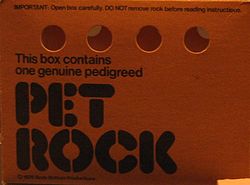This is an old revision of this page, as edited by Cybercobra (talk | contribs) at 00:41, 1 May 2010 (→External links: template). The present address (URL) is a permanent link to this revision, which may differ significantly from the current revision.
Revision as of 00:41, 1 May 2010 by Cybercobra (talk | contribs) (→External links: template)(diff) ← Previous revision | Latest revision (diff) | Newer revision → (diff) This article is about the fad. For the 1981 album by The Sinceros, see Pet Rock (The Sinceros album).

Pet Rocks were a 1970s fad conceived in Los Gatos, California by advertising executive Gary Dahl.
Development
In April 1975, Dahl was in a bar listening to his friends complain about their pets. This gave him the idea for the perfect "pet": a rock. A rock would not need to be fed, walked, bathed, groomed and would not die, become sick, or be disobedient. He said they were to be the perfect pets, and joked about it with his friends. However, he eventually took the idea seriously, and went home and drafted an "instruction manual" for a pet rock. It was full of puns, gags and plays on words that referred to the rock as an actual pet.
Marketing
The first Pet Rocks were ordinary gray stones bought at a builder's supply store. They were marketed like live pets, in custom cardboard boxes, complete with straw for the "animal". The fad lasted about six months, ending after a short increase in sales during the Christmas season of December 1975. During its short run, the Pet Rock made Dahl a millionaire. With the proceeds, he opened the ironically named "Carrie Nation's" bar in downtown Los Gatos, California.
In 1975, Dahl established Rock Bottom Productions, a company that sold the rocks for US$3.95 each. The stones, imported from Rosarito Beach in Baja California, Mexico, were swaddled in packing material (usually hay or straw for the rock's "comfort") and nestled in a small cardboard box (with air holes for the rock to "breathe"), similar to a pet carrier.
A thirty-two page official training manual titled The Care and Training of your Pet Rock was included, with instructions on how to properly raise and care for one's new Pet Rock (notably lacking instructions for feeding, bathing, etc.). The instruction manual was the real product: it was full of gags, puns and jokes. It contained several commands that could be taught to the new pet. While "sit" and "stay" were effortless to accomplish, "roll over" usually required a little extra help from the trainer/owner. "Come", "Stand", and "Shake hands" were found to be near-impossible to teach, but "attack" was fairly simple (also with some additional help from the owner). The owners/trainers also found that potty-training their pet rocks was fairly simple, given that they were, in fact, rocks.
Dahl's biggest expense was the die-cutting and manufacture of the boxes. The rocks only cost a penny a piece, and the straw was nearly free. For the initial run of booklets, Dahl had a printing job for a client and "tacked" the pet rock booklet onto the main job. This resulted in a batch requiring only a cut and trim, at almost no cost except some labor.
Availability
The original Pet Rocks are difficult to find today because new ones are no longer manufactured or sold. However, they can occasionally be found on eBay. People have also been known to make their own pet rocks, and some companies market variations on the pet rock concept. The online store thinkgeek.com sells a USB Pet Rock which recreates Dahl's original product down to its faux cardboard pet carrier box with straw bedding. The rock is also accompanied by an 18" USB cable and is advertised as being, "compatible with Windows (7 and lower); Mac (all OS's); Linux; and all other past, present, and future operating systems."
In 2009, Martin Abrams of the Mego Corporation bought the rights to the Pet Rock and began manufacturing it. His company, i-Star Entertainment, currently manufactures a new line of Pet Rocks that are sold at retail stores.
References
- ^
"The Latest Thing". Uncle John's Legendary Lost Bathroom Reader. Portable Press. p. 373. ISBN 1879682745.
{{cite book}}:|editor1-first=missing|editor1-last=(help) - Pet Rock Page from VirtualPet.com
- ^ Olson, James Stuart (1999). Historical Dictionary of the 1970s. Greenwood Publishing Group. p. 284.
- http://www.petrockpals.com
- http://ruby.sys-con.com/node/1180389/mobile
- Pet Rock Relaunch Press Release